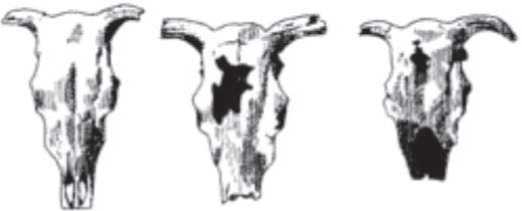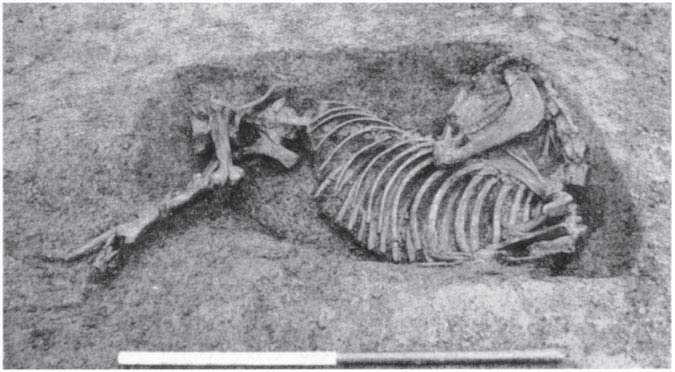An interesting aspect of animal-sacrifice concerns the criteria of selection. In many religions, the appearance, species, sex and age of beasts for sacrifice are important factors determining choice. Appearance is something we cannot generally trace archaeologically. That it may have mattered is implied by Pliny's comment in his Natural History22 that the two bulls chosen for sacrifice by the Druids on the occasion of the mistletoe festival on the sixth day of the moon were white. The Tables of Iguvium stipulate that for one of the gateway purification ceremonies, the three oxen sacrificed had to have white faces. This stress on whiteness may have been related to purity.
In terms of age, species and sex, certain inferences can be made from faunal assemblages on religious and sepulchral sites in Gaul and Britain. For example, pigs in some Gaulish cemeteries were young.23 At Skeleton Green (Herts.) it seems that male animals were buried with men and birds with women.24 At the sanctuary of Gournay, certain animals were old when sacrificed: the oxen (figure 5.4) were kept as long as ten years or more before slaughter and burial by the entrance.25
At Gournay, certain animals (the cattle and horses) were not eaten but buried as offerings to the chthonic or infernal gods, while young pigs and lambs were consumed in ritual feasts. There are many indications that certain animals were deliberately chosen for consumption and others left uneaten. The idea may have been that offerings to the infernal powers were left to rot, to seep into the earth and replenish it.

Figure 5.4 Skulls of oxen sacrificed at the Celtic sanctuary of Gournay-sur-Aronde, Oise. Paul Jenkins.
In some sanctuaries, part of the animal was eaten, part left for the gods: 'divided between gods and men and consumed by the latter'.26 Sometimes the killing and consumption of animals may have been accompanied by rituals whose purpose was to make reparation for the death of the animal (see chapter 3).
In all animal sacrifice or ritual for which there is evidence on Celtic sites, there is a distinction between consumed and unconsumed animals. At Bliesbruck the remains of beasts buried in pits were the domestic species generally eaten by Celtic communities (pig, cattle, sheep). There is difficulty, therefore, in distinguishing between daily life and ritual, by the assemblage alone. But the deposits are positioned deep within the pits and the shafts were then filled very rapidly, both activities arguing a non-functional pattern of behaviour which may reflect ritual practice. In the storage pits of southern Britain, by contrast, 'special deposits' of whole or parts of animals are distinctive in that they were definitely not eaten, a 'rare and uneconomic practice' but one which occurred consistently. There is a sharp contrast between these deposits and the waste products of butchery.27 People deliberately chose not to eat certain animals but rather to offer them to the gods, thus occasioning a considerable economic loss. Although much is made of the economic loss that uneaten animal deposits imply, and whilst this is undoubtedly true in some respects, there may have been a balance between religious and economic factors on some occasions. At Danebury in Hampshire, the most important animal in the economy of the hillfort was the sheep, yet in the many 'special deposits' in grain-storage pits, fewer are of sheep than of - say - the economically less useful dog or horse.28 This could have been a deliberate method of minimizing loss. Another way was to bury deposits of parts of animals, something which occurred at Danebury and elsewhere. Thus one could appease one's gods and feed one's family at the same time, so satisfying religion and reason.
In sanctuaries and graves, there is evidence both for offering uneaten meat to the gods (or to accompany the dead to the Otherworld) and for extravagant ritual feasting, where the animal was sacrificed for the living rather than for the dead or the divine. Brunaux has described religious functionaries as follows: 'Gallic sacrificers were perhaps no more than a specialized form of butcher.'29 Even butchery can be ritualized, not simply carried out functionally.30 Cooking, whether boiling, roasting or grilling, may also have been an integral part of sacrifice and ritual. In the circumstance of the sacred feast, meat could only be consumed within the context of ritual behaviour, which might involve special ways of despatching and preparing meat, just as pertains in Middle Eastern countries at the present day.
Meat-eating was widespread in sanctuaries, presumably as part of ceremonial feasts. Sometimes the animal appears to have been killed elsewhere with selected joints only brought into the shrine. This occurred at Gournay, where only certain portions of lambs were consumed. But often the killing, as a sacred act, would take place within the sacred space. There may also have been certain ritual activities which leave no trace in the archaeological record: there may have been blood-letting, for instance, for libations of blood to the gods; rituals associated with skinning; and prayers which preceded consumption. The devoured victim was sacred and the act of eating holy food was a kind of

Figure 5.5 Possibly sacrificial burial of an Iron Age horse found with a human in a grave during excavations for the extension of the Jubilee Line, at Stratford Langthorne Abbey, East London, in November 1991. By courtesy of London Underground and the Oxford Archaeological Unit.
Sacrament, which helped transfer the supernatural power to the consumer. We must remember also that any uneaten remains would have to be disposed of within the context of the religious ceremony,31 just as in Anglican acts of Communion the officiating priest will consume any wine that has not been used after it has been consecrated.
An interesting point about Celtic ritual feasting is the lack of wild species (see chapter 3), which are virtually unrepresented in these activities. This must be deliberate: domestic animals must have fulfilled some religious criterion that wild beasts did not. Maybe feasting was something which represented gifts from humans to gods, since humans were responsible for creating and tending domestic herds, whilst wild animals were perhaps perceived as belonging to the gods. Wild animals were sacrificed, as at the Digeon (Somme) shrine (see p. 125) but the wild species did not form part of the ritual meal.
Feasting ceremonies, as opposed to offerings of entire animals or joints of meat, leave traces of butchery on the bones. At some sanctuaries, there is further evidence: at Mirebeau (Cote d'Or), bones and broken pots strewed the floor of the shrine, redolent of a great feast or series of meals taking place within a sacred area.32 Feasting also took place at the sites of graves, perhaps performing similar bereavement rites to the wakes which accompany some modern funerals and which are essentially for the living rather than for the dead. Brunaux33 suggests that the elaborate animalheaded firedogs (figure 5.6) found in some rich Iron Age graves, and which were probably used to contain hearths, may have been associated with the role of animals in ritual feasting and sacrifice.




 World History
World History![The Battle of Britain [History of the Second World War 9]](https://www.worldhistory.biz/uploads/posts/2015-05/1432582012_1425485761_part-9.jpeg)









